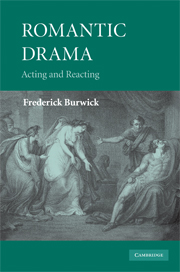Book contents
- Frontmatter
- Contents
- List of illustrations
- Acknowledgments
- Introduction
- 1 Periscopes into the theatre
- 2 Nationalism and national character
- 3 Genre: the realism of fantasy, the fantasy of realism
- 4 Acting: histrionics, and dissimulation
- 5 Transvestites, lovers, monsters: character and sexuality
- 6 Setting: where and elsewhere
- 7 Gothic and anti-Gothic: comedy and horror
- 8 Blue-Beard's castle: mischief and misogyny
- 9 Vampires in kilts
- Notes
- Bibliography
- Index
4 - Acting: histrionics, and dissimulation
Published online by Cambridge University Press: 04 August 2010
- Frontmatter
- Contents
- List of illustrations
- Acknowledgments
- Introduction
- 1 Periscopes into the theatre
- 2 Nationalism and national character
- 3 Genre: the realism of fantasy, the fantasy of realism
- 4 Acting: histrionics, and dissimulation
- 5 Transvestites, lovers, monsters: character and sexuality
- 6 Setting: where and elsewhere
- 7 Gothic and anti-Gothic: comedy and horror
- 8 Blue-Beard's castle: mischief and misogyny
- 9 Vampires in kilts
- Notes
- Bibliography
- Index
Summary
In the period from David Garrick (1717–79), through Sarah Siddons (1755–1831) and John Philip Kemble (1757–1823), the use and understanding of gesture underwent radical changes affecting conventions in acting. Classical works on gesture discussed ways in which movement of the body and hands, tilt of the head, gait, and movement of legs and feet display attributes of gender, of age or state of health, of social class and profession. Studies of chironomia had, from Elizabethan times, replicated the same description of arm and hand gestures with the same prescription for their rhetorical use. During the latter half of the eighteenth century there was a growing recognition of how gesture revealed or defined character. Gesture in acting too was seen to have other implications beyond expressing thought or feeling. It enabled a character to construct the very space upon the stage. With the point of a finger or the sweep of an arm, height, depth, direction, motion are defined. Books on gesture began to deliberate on more complex instincts and motives influencing the body movement. Corresponding changes were taking place in figure painting and acting.
Michael William Sharp's “Essay on Gesture,” delivered as a lecture to the Philosophical Society at Norwich in 1820, makes the case that gestures not only reveal emotions; they also reveal even those emotions that a person might strive to conceal. Sharp's point is that gesture is an instinctively honest language, often exposing a truth that a speaker may attempt to deny or disguise.
- Type
- Chapter
- Information
- Romantic DramaActing and Reacting, pp. 80 - 114Publisher: Cambridge University PressPrint publication year: 2009



